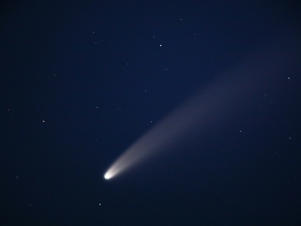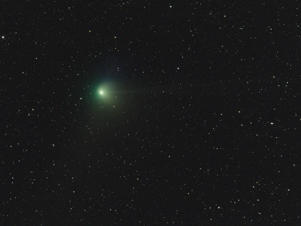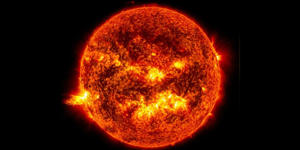
© Provided by Business Insider Comet C/2020 F3 (NEOWISE) that passed the Earth in 2020. Scientists expect comet C/2023 A3 will be even brighter. Alexander Ryumin/TASS via Getty Images
- Astronomers have spotted a newly-referenced comet that is heading towards Earth.
- The comet is likely to be so bright it could outshine our stars.
- The last time the comet visited Earth was around 80,000 years ago, astronomers said.
A recently-spotted comet is expected to shine brighter than the stars in the night sky as it passes our planet, according to astronomers.
The comet, named C/2023 A3, is hurtling toward the Earth at about 180,610 mph, per space.com.
If all goes well, the comet, which last passed by the Earth about 80,000 years ago, will start being visible with the naked eye around October 2024, according to data from the Minor Planet Center.
It could be as bright or brighter as our stars, and much more brilliant than the recent ZTF green comet that passed the Earth last month.
Brighter than the Green Comet
C/2023 A3 is expected to reach a brightness magnitude between -0.7 and -5, per space.com. That technical term means it will potentially be as bright as Venus in our night skies.
By comparison, the recent Green Comet ZTF had a brightness of around magnitude +4.6 (the lower the magnitude, the brighter), per space.com.

© National Astronomical Observatory of Japan Comet ZTF (C/2022 E3) taken at NAOJ Mitaka Campus on January 31, 2023. National Astronomical Observatory of Japan
That means C/2023 A3 has the potential to be at least about 100 times brighter than ZTF, and six times brighter than NEOWISE, a comet that grazed the Earth in 2020, according to Ukrainian astronomy magazine The Universe. Space. Tech.
But of course, these are just predictions, and a lot could happen to the comet before then.
For one, the comet will have to survive the sun. The ball of gas, ice, and dust is now heading toward our star and it will have to survive its smoldering rays. The critical moment will be its perihelion — its closest approach to the sun — on September 24, 2024.
Still, scientists are hopeful, according to the Universe. Space. Tech., because the comet is expected to be quite large and its perihelion is far from the sun, about 36 million miles away.
NASA keeps a close eye out for objects that graze the Earth
C/2023 A3 was spotted on February 22 by the NASA-funded asteroid early detection system Asteroid Terrestrial-impact Last Alert System (ATLAS).
The system, operated by the University of Hawaii, is made up of four telescopes placed in Hawaii, Chile, and South Africa. These automatically scan the sky to spot potential threats to Earth coming from the sky.
NASA keeps a close eye on near-Earth objects that could hurt our planet, but it doesn’t always catch them this early.
For instance, NEOWISE was spotted only three months before it passed by the Earth in 2020. On that occasion, we were lucky and the comet only passed our planet, offering spectacular vistas to onlookers.
C/2023 A3, however, isn’t expected to be a planetary threat. Astronomers think it will pass about 0.5 Astronomical Units, or 44 million miles, from our planet.






